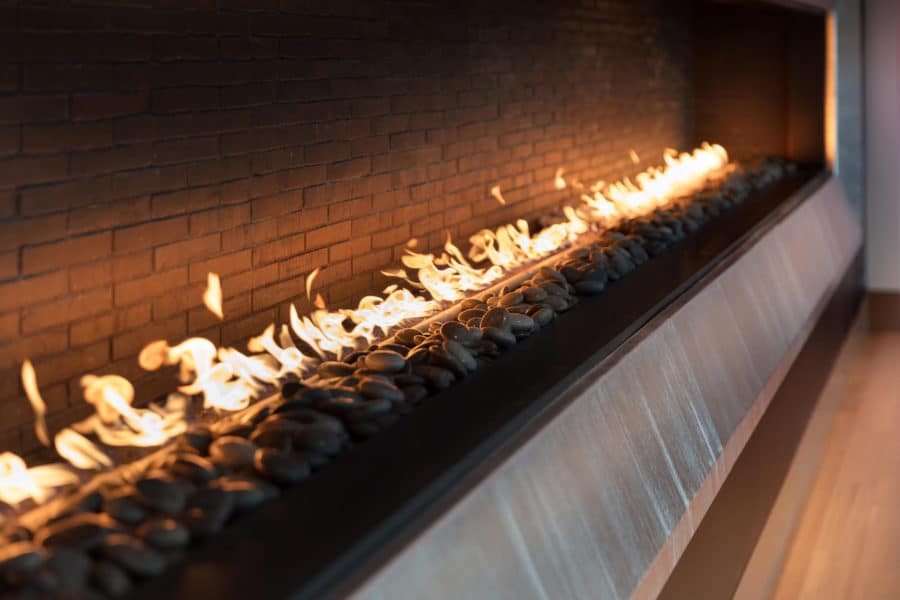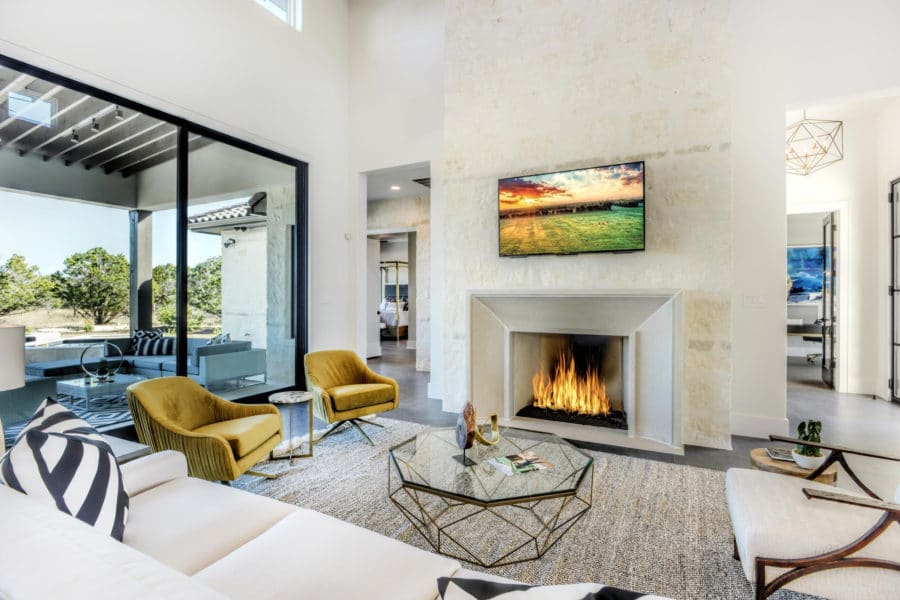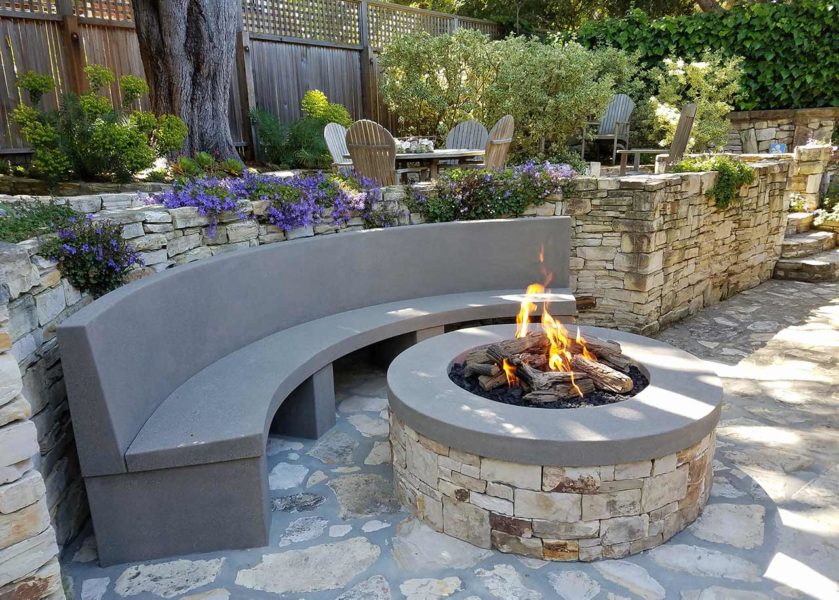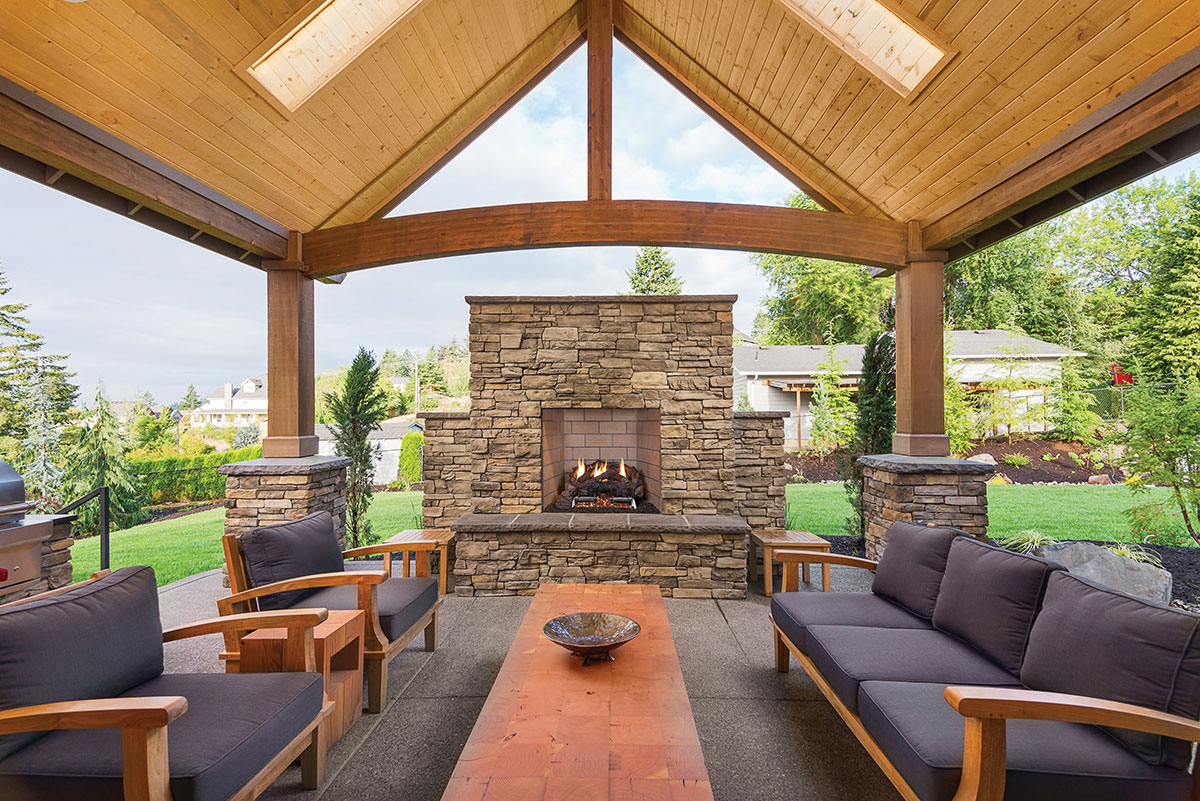Story at a glance:
- As outdoor living grows in popularity, fireplaces too offer a way to bring the outside in.
- Many electric or gas linear fireplaces options offer a sustainable centerpiece that complements modern decor.
- One innovative wood stove surpasses current particle pollution standards, outshining competitors.
Bringing fire indoors is an ancient practice harkening back to our cave-dwelling days on the planet. While its original purpose was survival, today’s indoor fireplaces represent so much more to meet our instinctive attraction to fire.
For example, modern advances in fireplace technology largely eliminate pollution, allowing users to indulge in fire’s mystique in a sustainable way. Interior designers can seize on fire’s appeal in creating a warm ambience in or outside of buildings where controlled flames brighten and add warmth as focal points social spaces.
Let’s explore some sustainable fireplace design ideas.
Linear Fireplaces

Balthazar Cellars is a 16,700-square-foot, stone-clad facility designed by architect Bill Curtis. The final build is a two-story wine storage facility with several second-floor entertaining venues, including this fire feature. Photo courtesy of Earthcore
A linear fireplace is a rectangular electric or gas fireplace insert installed within a wall. Stunning in its simplicity, a linear fireplace enthralls onlookers with its clean lines, making it the perfect complement to a contemporary style of interior design.
Linear fireplaces entered the design scene with Earthcore 30 years ago offering an alternative to traditional brick or metal fireplaces with clay linings. As a company Earthcore is as sustainable as they come, being almost carbon neutral (less than 1% carbon footprint) and using nearly all of its materials during manufacturing.
Why Isokern?

Earthcore can customize the fireplace of your dreams. The fireplace manufacturer uses Isokern pumice stone from Iceland in every project. Photo courtesy of Earthcore
Using sustainable isokern pumice from Iceland, the company makes installation easy through modularizing construction into lightweight pumice projects. Pumice stones are highly pressurized, created from gas bubbles infused into volcanic molten magma.
The pumice in isokern fireplaces is responsible for quick heating and long heat retention times, making it more efficient than the traditional brick installations.
“Fire and concrete don’t like each other. It eventually cracks and fails. You’re using materials that are 6,000 years old. Nothing beats a volcano,” Carl Spadaro, CEO of Earthcore, previously told gb&d. Plus, no large cranes or work crews are required to install one of Earthcore’s linear fireplaces.
The highly customizable Maximus Linear series by Earthcore does without a false wall or a double glass on the opening, eliminating material excess as a sustainability feature of these fireplaces. They were intentionally designed not to burn room air to meet the requirements of some places, like California, that are banning such fireplaces.
“More and more cities are implementing the no-burning room-air policy for fireplaces, so we have to be ahead of the curve before it becomes mandatory,” Ernest Maranan, a product development and testing engineer on Earthcore’s engineering team, previously told gb&d.
Brian Thompson, a home builder in Houston, Texas, has installed Earthcore fireplaces for 15 years. He notes their efficiency and appearance but especially the cost savings. Although materials for Isokern fireplaces cost more than brick, labor costs are low. “Masonry might take a week,” Thompson told gb&d. By contrast, Isokern fireplaces are assembled in less than a day. “They go together like Lincoln Logs.”
Types of Fireplaces

Through their unique use of a hollow baffle system, Pacific Energy’s non-catalytic stoves perform under the two-gram standard. Photo courtesy of Pacific Energy
Designers have a number of options for sustainable fireplaces. These include:
Wood Stoves
Wood stoves by Pacific Energy are worlds above their highly polluting predecessors. “With a modern wood stove and dry wood, you don’t see smoke. That’s the bottom line,” Cory Iversen, sales manager for Pacific Energy, said in a previous gb&d article.
Pacific Energy reduces the particulate matter pollution of its wood stoves under EPA’s latest 2-gram standard without catalytic technology that usually fails well before its time. With their eye on long-term sustainability, Pacific Energy has developed catalytic-free stoves using secondary burn systems in which clean, preheated air is injected into the unburned particulate of the fire.
In their non-catalytic True North line of wood stoves, a perforated steel tube baffle situated across the top of the firebox introduces air across the top of the stove, maximizing combustion.
Pacific Energy’s floating firebox system, which allows parts to expand and contract without wearing on the metal, is unique. This system adds years to a stove’s life along with a creosote-free viewing window. Pacific Energy is also said to be the first in the industry to introduce an air wash manifold system, keeping combustion air flows across the glass surface clean.
Gas-Fired Outdoor Fire Features

The size and shape of a fire feature like this one from Warming Trends depends on whether it’s a focal point, accent, or used to help define spaces. Photo courtesy of Dragonfly Ponds and Patios
Warming Trends, a Denver-based company, designs and manufactures custom gas fire features for outdoor spaces. With patented CROSSFIRE burners, they generate increased internal pressure and turbulence at the point of ignition, resulting in a taller, more vibrant flame that captures the essence of a wood fire in fullness and color.
CROSSFIRE brass burners also have industry-leading fuel efficiency, enabling the system to create roaring flames sustainably if desired. “The reason fuel efficiency matters to our company is because it can really matter to our customers,” Voni Flaherty, the owner of Warming Trends, said in an earlier gb&d article.
Warming Trends thrives on clients’ requests and views every customization as an opportunity to expand the beauty and potential of fire’s captivating spell. “The modularity of our burner systems together with our Colorado-based production facility gives us the most design creativity and liberty in the industry. That combination also gives us a very short custom turnaround time from design to delivery,” Flaherty says. “Our manufacturing and production processes allow us to replicate almost any configuration as long as it’s within the client’s budget and local codes. You dream it; we’ll build it.”
Just like with indoor fireplaces, there are many design possibilities. “From GFRC to metal, fireplace versus pit, and natural stone to veneer, there are many design options available. If the project has a lot of curvature and rounded shapes to it, naturally you may offer a feature that is either circular or radial. If the project has sharp corners and angles, a square or rectangular feature is usually the right option. If you can draw it on a napkin, we can design it,” Bryan Small, vice president of sales at Warming Trends, previously told gb&d.
Outdoor Fire Features

Photo courtesy of Fire Pits Direct
Roasting marshmallows around a campfire is a favorite tradition that promotes social togetherness and intimate conversation. Modern firepits and other outdoor fire features provide plenty of opportunities to interior designers to capture that feeling.
For outdoor applications, firepits, fire tables, and fireplaces are seamlessly integrated into living and dining areas. Fire torches, bowls, and in-ground features could be incorporated within landscape designs. Designers may even include fire elements in landscapes distant from buildings to accent waterfalls, pools, or ponds on the property.
“Many people who choose to add fire features are looking to restore the timeless scene of sitting around the fire. We sell fire, of course, but more importantly, what we aim to do for our clients is create environments intended to inspire conversation,” Adam Kahler, director of sales and marketing at Fire Pits Direct, previously told gb&d.
Today designers can find something for every style and budget from firepit tables to outdoor fireplaces and torches to fire glass. For instance, glass fiber reinforced concrete (GFRC) fire features provide structural stability to fire enclosures. “If your ambient temperature is really cold, you want to be able to ignite a gas fire feature and not have to worry about the integrity of the actual enclosure itself,” Kahler says.
Smart fire features are also trending in the outdoor fire space. Fire Pits Direct offers Bluetooth-controlled features and other smart home technology with electronic ignition fire pit kits offering remote electronic ignition with Hi/Lo flame options and security features.
Customization of unfinished fire pits is an option offered by some companies. Stucco or stone are just two examples clients may choose. “Every firepit is handcrafted and is truly like a piece of art,” Kahler says.


